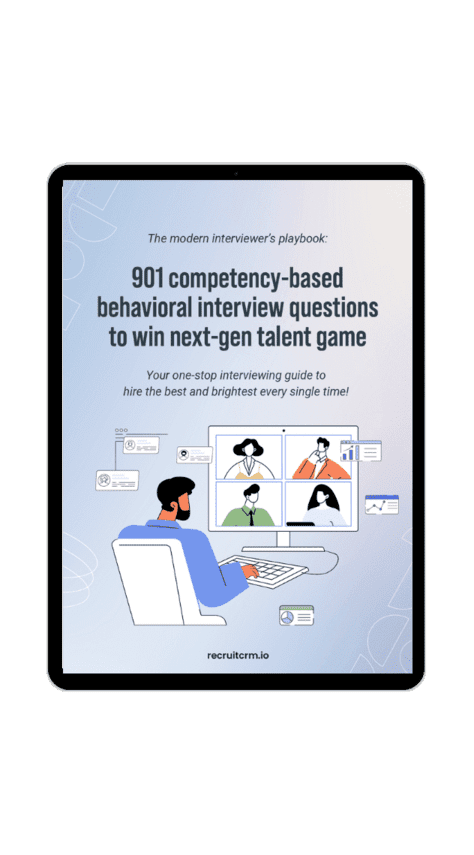Attracting and hiring the best talent is crucial for any business. But the recruitment process can be time-consuming, complex, and prone to errors.
If you want to scale your hiring efficiently, then it’s time to embrace enterprise recruitment software, a powerful system that helps companies streamline and automate various aspects of their hiring process.
From its key features and benefits to best practices and future trends, here’s the inside scoop on everything you need to know about this game-changing recruitment technology.
What is enterprise recruitment software?
Enterprise recruitment software is a software usually used by hiring managers to streamline and automate the entire recruitment process.
It includes features like automated job posting, resume management, applicant tracking system, candidate communication, and reporting and analytics.
This recruitment tool aims to make the ecosystem more efficient and cost-effective, allowing you to save time, increase workflow, and make data-driven hiring decisions.
This is a central system where recruiters can easily keep track of all open positions, referrals, candidates’ progress, and send automated updates with ease.
An enterprise recruitment software enables the recruitment team to focus on building relationships with candidates rather than getting bogged down in manual, repetitive tasks.
9 major benefits of using enterprise recruitment software for businesses
1. Automates repetitive tasks
Isn’t that a blessing?
Enterprise recruitment software can significantly reduce a recruiter’s workload by automating tasks such as sending emails, scheduling interviews, and posting job openings.
This allows them to focus more on important tasks that require a human touch, such as managing employer branding and conducting one-on-one interviews.
2. Improves candidate experience
A great candidate experience is a must for hiring success in 2023.
Enterprise recruitment software offers a user-friendly interface for candidates, making it easy for them to apply to job boards and follow up on their status. This can not just lead to a positive candidate experience, but also keep them engaged with the recruitment process and accept any upcoming job offer.
Businesses can also use recruiting software to better communicate with candidates, providing them with timely updates and information about the hiring process.
3. Increased efficiency
Using automated tasks and centralizing candidate data can streamline the recruitment process and reduce the time taken to find and evaluate and source candidates.
This software can also make it easier for recruiters to collaborate, communicate with hiring managers, and make decisions effectively.
4. Enhances collaboration
An enterprise recruitment software solution makes it easier for recruiters, hiring managers, and candidates to collaborate and communicate with one another.
This can lead to a more efficient hiring process, as recruiters are able to quickly share information and receive feedback in no time.
5. Reduces costs
This one is a deal breaker!
By automating tasks and reducing the need for manual labor, enterprise recruiting software can help businesses significantly reduce recruitment spending.
The use of recruitment software can also help businesses comply with regulations, including equal opportunity laws and data privacy regulations, which reduce legal risks and costs.
6. Better tracking
It allows recruiters to track each candidate throughout the recruitment process, so nothing slips through the cracks.
7. Faster hiring
With streamlined processes and efficient tracking, the time-to-hire can be reduced significantly, allowing recruiters to fill positions faster and maintain a competitive advantage.
8. More engagement
By providing a positive candidate experience and efficient communication, the hiring tool can enhance candidate engagement and encourage passive candidates to actively pursue opportunities with the organization.
9. Improves recruitment marketing
Enterprise recruitment software helps improve recruitment marketing by providing tools to automate and optimize job postings, track candidate engagement and analyze data to measure the effectiveness of recruitment strategies.
4 different types of enterprise recruitment software available in the market
With the rapid advancements in technology, the market offers a wide range of hiring tools that cater to the specific needs and requirements of businesses.
Here are some of the common types of recruitment software available-
1. Applicant tracking systems (ATS)
An Applicant tracking system (ATS) is a software solution to streamline recruitment.
It is used to track and source qualified candidates, screen CVs, create reports, schedule interviews, and a lot more to help organize your recruiting workflow better.
ATS can also provide valuable data and insights into recruitment metrics such as time-to-hire, cost-per-hire, and candidate sources, allowing organizations to make data-driven decisions and improve their recruitment results.
2. Candidate relationship management (CRM)
Candidate relationship management (CRM) is the lifeblood of enterprise recruitment.
From the initial touch point to the final decision, CRM keeps you in touch with your candidates. You can easily track communication history, schedules, interview feedback, and more.
With all this information in one place, you’ll always have a 360-degree view of your candidate’s journey and be able to focus better on other tasks as well.
3. Video interviewing software
A video interview is a type of job interview that uses video technology as the primary method of communication.
Video interviews are becoming increasingly popular among organizations looking to simplify the traditional interview process. This innovative approach is utilized at various stages of the recruitment process, from initial screening to final interviews.
These interviews save time and provide a deeper connection, offering the perfect blend of efficiency and personalization.
4. Diversity and inclusion software
D&I software is a type of enterprise recruitment software that helps companies promote diversity and inclusiveness in their hiring practices.
It can assist with various aspects of the recruitment process, including job postings, performance evaluation, analytics, and training.
This software can help organizations create a more diverse and inclusive workforce and foster a positive company culture by bringing different views to the table.
Top 5 enterprise recruitment software to invest in 2023
The online market is full of recruitment software, each with unique bells and whistles. But which one is best for your enterprise?
We can’t tell.
It all depends on your enterprise-specific needs and requirements.
Don’t worry; we aren’t abandoning you with just that! Here are the top 5 enterprise recruitment software you should definitely check out.
1. Best overall – Recruit CRM
Recruit CRM is an end-to-end ATS and CRM system designed to assist recruiters, businesses, and enterprises in meeting their hiring needs.
Its powerful resume parsing engine, in-built email triggers, Boolean search functions, talent pool management features, job posting, clear Kanban views, etc., allow its users to centralize their applicant management in one place.
In short, it has everything you might need in your ideal enterprise recruitment software. Learn more about Recruit CRM’s features here.
Why invest?
- Recruit CRM’s 24/7 customer support service aims to help its users with their queries within just 2 minutes
- Its drag-and-drop functionality makes moving candidates through the pipeline quick and easy
- Its Chrome Sourcing Extension helps source potential candidate profiles from anywhere on the internet and store them in its database
- Flexible plans and pricing
Free trial: Available for an unlimited period of time. Feel free to book a demo with their product specialists using this link.
2. Best for pre-employment assessment- iMocha
iMocha is an AI-powered talent acquisition and development platform that has expertise in measuring the skill competency of new and existing candidates.
With its vast skill assessment library, coding simulators, and other functionalities, iMocha helps large enterprises shortlist candidates based on relevant skills and automatically generates performance reports.
Why invest?
- iMocha claims to offer a “free of human errors” skill evaluation process.
- Its assessment flag function helps recruiters easily catch cheating attempts made by candidates during the assessment.
- Its pre-employment evaluation function can reduce up to 40% of the recruiting time.
Free trial: Available
3. Best for applicant tracking- Greenhouse
Greenhouse’s enterprise recruitment software helps manage the entire recruitment cycle from job posting to candidate onboarding.
It lets its users measure, iterate and improve their hiring process to meet their specific needs and requirements.
It’s an excellent tool for organizing the employment process while maintaining transparency. Its specially curated scorecards, interview kits, api and analytics dashboard help enterprises reduce biases and identify the best talents.
Why invest?
- Greenhouse’s ATS helps gather and store all the feedback and scorecards in one place.
- It allows quick integration with emails and LinkedIn, making application tracking hassle-free.
- It offers a flexible interview scheduling feature- candidates and the interviewer can edit the timing and state the reason for rescheduling.
Free trial: Available
4. Best for smooth onboarding process- ClearCompany
ClearCompany aims to help large enterprises identify, hire, engage, and retain potential candidates.
It provides valuable insights about candidates and the hiring workflow by understanding their goals and role in the company.
Its major functionalities include performance management, workforce planning, employee engagement, and smooth onboarding of new hires.
This software also enables companies to quickly transfer talented candidates from prospective employees to top performers through constant evaluation of their performances.
Why invest?
- The software’s UI is easy to follow and customize.
- It offers scorecards for fair and faster candidate evaluation.
- Its simple workflow aids in the screening of applications through multi-level metric analysis.
Free trial: Not available
5. Best for candidate relationship management- Beamery
Beamery is a Talent Lifecycle Management platform that allows enterprises to track and nurture their relationship with clients and candidates. It focuses on offering more human experience for candidates throughout their hiring journey.
Its AI-powered CRM gathers all communication data and documents to identify and acquire top talents, enhance DE&I, and close critical skill gaps within the organization.
Why invest?
- It offers functionalities such as talent pool search, campaigns, events, templates and comprehensive integration options.
- With Beamery, you can track all the interactions of your email campaigns.
- Its convert-flow feature lets you create forms that make gathering candidate information hassle-free.
Free trial: Available
Mind that this list is subject to change, and new players may emerge in the market.
It’s best to research and compare various enterprise recruitment software features and capabilities to determine the best fit for your agency’s specific needs and requirements.
5 key components to consider when choosing enterprise recruitment software
Let’s discuss the 5 top imperative features to consider when selecting the right enterprise recruitment software.
1. User-friendly interface
An easy-to-use interface is one of the most important features of an enterprise recruiting solution.
It should be easy to use and navigate so that hiring managers can quickly and efficiently manage their recruitment processes without having to worry about reaching out to people to interpret the know-how.
An intuitive interface can help to minimize errors, increase productivity and offer a smooth flow of information throughout the recruiting team.
2. Customizable workflow
The tool should have a customizable workflow that can be tailored to your organization’s specific needs and workflow.
Every agency has its own perspective on recruitment; therefore, it is nearly impossible to have a recruitment tool that satisfies all the requirements without the touch of personalization.
This feature allows recruiters to set up and manage the hiring process in a way that works best for their organization.
From posting job ads on social media to managing resumes and applications to scheduling interviews and making job offers, a customizable workflow can help streamline the entire hiring process.
3. Reporting and analytics
Metrics are indeed the closest friends of a recruiter.
Reporting and analytics are vital features that can help HR staff track their recruitment process’ success.
The recruitment software should be able to provide detailed reports and analytics, such as time-to-hire, cost-per-hire, and applicant source, to help HR staff make informed decisions about their hiring process.
A relevant set of statistics also helps to track fall-outs and identify their root causes.
4. Applicant tracking system (ATS)
An ATS system is a critical component of enterprise recruitment software.
The ATS should be able to store and manage resumes and applications so that recruiters can easily find and track suitable candidates.
It should also have a search function that allows you to search for candidates based on specific criteria, such as keywords, skills, or experience.
While an ATS comes with a splendid platter of features, these are some of the most crucial ones that you must get your hands on.
5. Collaboration and communication tools
Finally, Enterprise Recruitment Software should have collaboration and communication tools that allow recruiters to work together and communicate effectively.
Communication and collaboration, two principal recruitment factors, significantly impact how effortlessly the whole hiring procedure takes place in an organization.
The tools should include features such as shared calendars, task lists, and messaging systems to ensure that everyone is on the same page and working towards the same goal.
A centralized collaboration and communication channel allows information to flow smoothly through all the channels in your team.
6 best practices for using enterprise recruitment software
Whether you’re a seasoned pro or just getting started, these tips will help you make the most out of your technology investment and find the cream of the crop for new hires.
1. Clearly define requirements
Before selecting a recruitment software, it’s crucial to identify your company’s specific needs and requirements.
This could include things like the size of your company, the types of positions you’re hiring for, and any specific features or functionalities you require.
Having a clear understanding of what you’re looking for will help you make a more informed decision.
2. Test and evaluate
With so many recruitment software options available, it’s important to take the time to test and evaluate different options.
Try out different software through trials or demos to see which works best for your needs.
3. Involve stakeholders
Recruitment in organizations is a collaborative process; everyone concerned deserves a say in the decision.
Including HR, recruiters, and hiring managers in the software selection process is important since recruitment affects multiple departments and stakeholders.
This will ensure that their needs are considered, and the software you choose meets their requirements.
4. Customize
Customizing the enterprise recruitment software is important in making it work effectively for your organization.
Instead of using the software as it is, it must be adapted to meet your specific needs.
Some standard customization options include creating custom fields to capture specific information, setting up custom workflows to reflect your organization’s hiring process, configuring notifications to keep everyone on track, etc.
5. Ensure data security
Data security is a critical consideration when implementing enterprise recruitment software.
It’s important to pick a software provider with robust security measures, including encryption of sensitive data, secure servers, and access controls.
It’s also important to have internal controls in place to protect sensitive data. This may include restricting access to sensitive information to only those requiring it, monitoring data access logs regularly, and conducting regular security technology audits.
By ensuring data security, you can protect your organization from security threats and maintain the trust of your employees and candidates.
6. Integrate with other systems
You can maximize your recruitment efforts by integrating enterprise recruitment software with other HR systems.
Integration can help eliminate manual data entry and reduce the risk of errors. It can also help ensure that your recruitment data is up-to-date and accurate.
Top 5 challenges faced in implementing enterprise recruitment software and how to overcome them
The implementation process of an enterprise recruiting software can come with several challenges that recruiters must learn to overcome.
Here we will discuss the common challenges faced while setting up the tool up and how you can easily eradicate them with time.
1. Resistance to change
One of the biggest challenges faced in implementing software is resistance to change, which arises from nowhere but the internal recruiting team itself.
Recruiters are often hesitant to adopt new technology into their system, mainly if they have consistently used traditional hiring methods for a long time.
Organizations need to communicate these differences in enthusiasm and preach the benefits of the software to bring everyone on the team under the same shade.
A good approach is to provide specialized training to ensure that the recruiters are comfortable using the new system.
Establishing brand-new software is not only a heads-up for the organization but also a powerful instrument for the recruiters to find convenience and ease in their work.
The main aim should be to make the recruiters aware of it.
2. Integration with existing systems
Another challenge is integrating the software with existing systems. The principal motive behind installing software is mostly to centralize the workflow in the hiring team.
And that can only be achieved through integration.
The software should be able to seamlessly integrate with other HR systems, such as HRIS, ATS, and payroll, to ensure that all relevant data is accurately captured and processed under one roof.
Organizations should work with their software provider to ensure that the integration process is smooth and seamless without spending too much time figuring out everything themselves.
3. Data migration
Upon incorporating new software into the system, recruiters are burdened with an urgent need to transfer all existing candidate information and hiring data to the new system.
This process is definitely time-consuming and complicated, especially if the data is stored in different formats or locations.
Undoubtedly, this creates a sudden burden on recruiters and may result in the abrupt termination of an ongoing recruitment process.
All these threats make it essential for an organization to plan and execute the data migration process carefully to ensure that no data is lost or corrupted during the transition.
4. Customization and configuration
When purchasing software, organizations should put special efforts into ensuring that it can be customized to meet the specific needs of the recruiters.
But simply having this feature isn’t enough. The REAL challenge is to adapt and interpret it to use it judiciously for the purpose it is meant to serve.
Traditional recruiters are often not so familiar with the software and its configuration options, making them a bit skeptical about diving in and exploring the functionalities and scope it comes with.
The best way to overcome this limitation is to seek help from the software providers to guide your recruiting team through the procedure until they are confident with the know-how and can do it all quickly.
5. Training and user adoption
Training and user adoption play a huge part in embracing new software into your system.
Recruiters need to be trained on how to use the software effectively and efficiently to ensure that your team uses it to its highest potential.
Investing heavily in software and underusing it is the last thing a company wants.
A company should provide ongoing training and support for recruiters to help them break down their tasks into simpler and more effective ones and be comfortable using the new system.
Top 5 future trends in enterprise recruitment software
The future of enterprise recruitment software is likely to be shaped by the following trends:
1. Real-time analytics and reporting
Predictive analysis will become a major part of enterprise recruitment software, allowing companies to assess, anticipate and analyze candidates’ behavioral patterns to make better hiring decisions.
Recruiters will correlate gathered data to determine candidates’ profiles and weed out unqualified ones.
They will also use real-time analytics to track the success and failure of their hiring process and make necessary improvements.
Predictive analysis will enable recruiters to quickly skim through the application clutter, recognize the “high potential” candidates, and connect with them before their competitors do so.
This will also improve the software’s algorithm for candidate evaluation, thereby strengthening the diversity of the talent pool.
2. Gamification
Gamification isn’t just about games; it is a fun way for companies to engage their talents, motivate behavioral changes, and improve their experience throughout their hiring journey.
Modern enterprise recruitment software uses features like game algorithms, intelligent segmentation, structures, and feasibility to test their applicants.
In 2023 and beyond, recruiters will employ gamification in their candidate evaluation process via short tests, assignments, and other activities that are carried out through digital media.
New applications and strategies will be integrated into the conventional enterprise recruiting software to bring gamification into effect at both personal and professional levels.
3. Chatbots
The concept of using HR Chatbots is not new but has recently gained attention from around the corners.
Staffing professionals worldwide have been discussing chatbots’ significance and future in improving interaction with candidates.
With its ability to understand natural language input from us and respond quickly and accurately, it does a great job as a first point of contact for candidates.
In the future, most enterprise recruitment software will have in-built AI chatbot facilities to help recruiters accelerate their HR process and enhance their candidate experience strategies.
4. Virtual and augmented reality
Virtual and Augmented reality are technologies that every recruiter must keep their eyes on.
As artificial intelligence is already impacting the staffing industry in more ways than we could ever imagine, it won’t be difficult to predict AI/VR trends to take over the industry in the future.
With VR and AR, candidates can experience job interviews in real-time, even if they are happening miles away.
Recruiters will be able to assign group activities or other relevant tests to evaluate candidates’ performance with their own eyes, irrespective of their physical presence.
Recruiting software supporting VR will be the most preferred tool for attracting candidates, organizing virtual job fairs, training employees, etc.
5. Expansive hiring criteria
Enterprise recruitment software helps recruiters identify potential candidates, track them, and manage their applications.
With its customizable interface and screening filters, recruiters can quickly sort candidates based on criteria like demography, experience, qualifications, etc.
Modern HR software also offers built-in chat features that allow recruiters to message candidates directly within the system.
With all such features, it’s evident that recruiting software will evolve even more in the coming years.
There will be better options to assess candidates’ soft skills based on psychometric tests, or maybe something crazier that time will tell.
Frequently asked questions (FAQs)
1. How do enterprise systems work?
Enterprise systems are like the control center of a big organization.
They help manage and streamline important processes like finance, human resources, and supply chain management.
Think about it, if everyone in an organization had their own way of doing things, it would be chaos! But with an enterprise system, everyone is on the same page. The system collects information from different departments and puts it all together, like a giant filing cabinet.
This makes it easy for everyone to access and share information.
2. Is enterprise recruiting solutions legit?
Some of the enterprise recruiting solutions are legitimate and have been shown to be effective in assisting businesses in managing their recruitment activities, whereas others may not have a good reputation and may be less effective.
The best way to determine if a particular enterprise recruiting solution is right for your organization, conduct thorough research and evaluate the available options in the market.
On that note, if you want to learn how Recruit CRM can help you nail your enterprise recruitment game, book a demo now with our product specialists. We’d be more than happy to bring you over to our winning team and show you all our power-packed features in action!
Happy recruiting!






